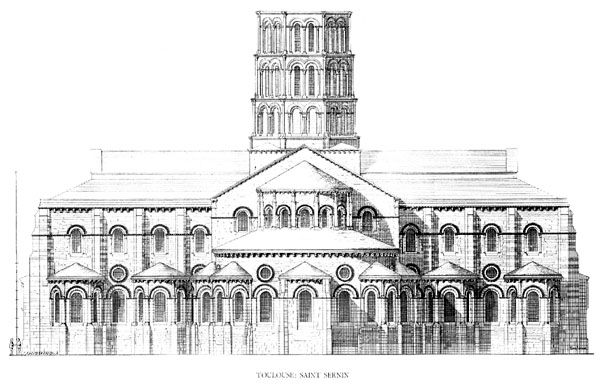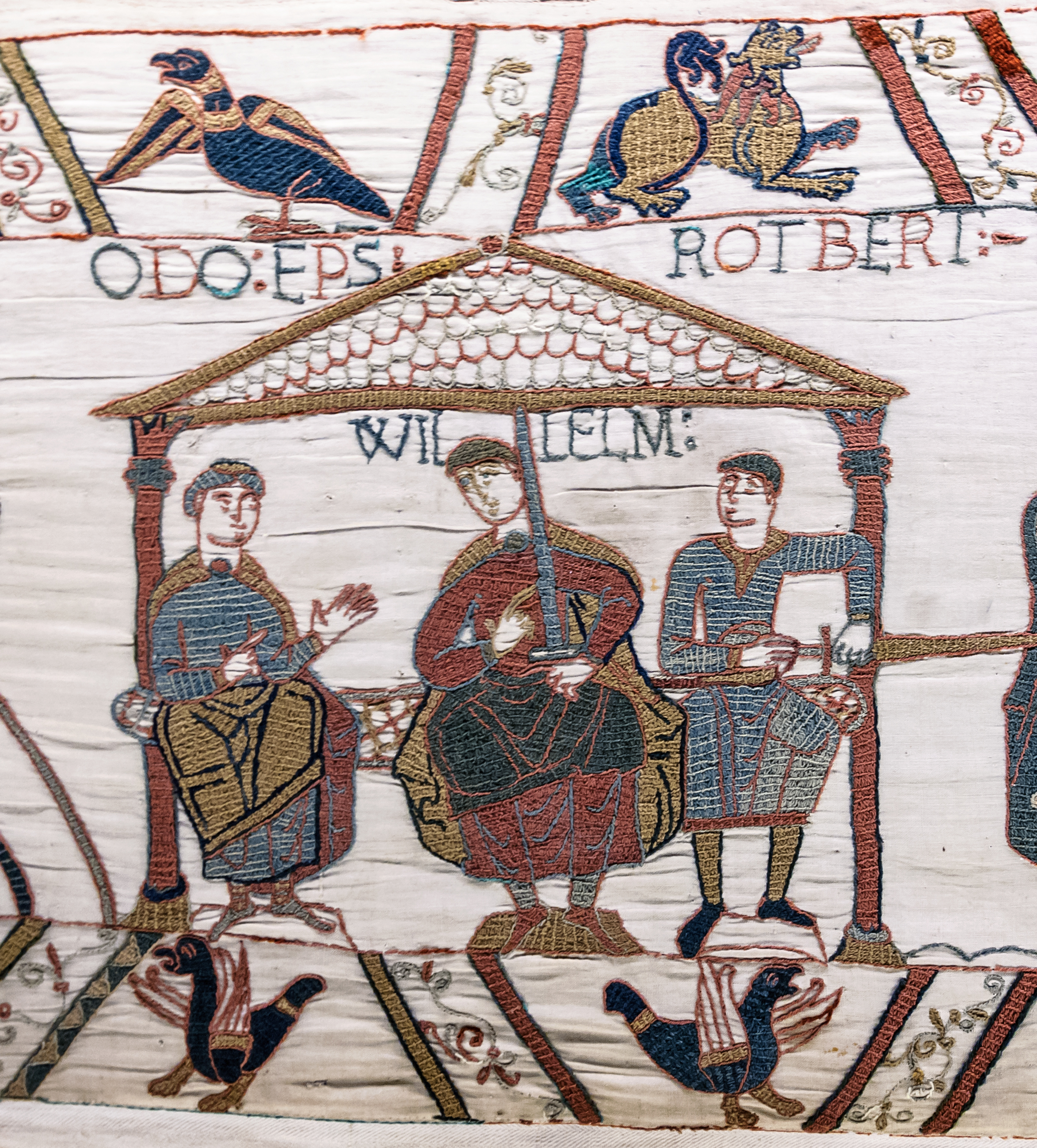|
Westwork
A westwork (german: Westwerk), forepart, avant-corps or avancorpo is the monumental, often west-facing entrance section of a Carolingian, Ottonian, or Romanesque church. The exterior consists of multiple stories between two towers. The interior includes an entrance vestibule, a chapel, and a series of galleries overlooking the nave. A westwork is usually broader than the width of the nave and aisles. It is sometimes used synonymously with narthex. Charlemagne dreamt of reviving the Roman Empire in the West. His dream along with his artistic skillset allowed him to implement artwork into buildings with westwork during this time period and can be found in the Corvey Abbey and scattered throughout other westwork buildings today. The Corvey Abbey (built in 885) located in Germany is the oldest example of westwork to date. The Corvey Abbey provides an example of westwork preserved from the time being built. The frescos (originally of the 9th century) inside the westwork show scenes ... [...More Info...] [...Related Items...] OR: [Wikipedia] [Google] [Baidu] |
Corvey - 2017-09-23 - Westwerk (07)
The Princely Abbey of Corvey (german: link=no, Fürststift Corvey or Fürstabtei Corvey) is a former Benedictine abbey and ecclesiastical principality now in North Rhine-Westphalia, Germany. It was one of the half-dozen self-ruling '' princely abbeys'' of the Holy Roman Empire from the late Middle Ages until 1792 when Corvey was elevated to a prince-bishopric. Corvey, whose territory extended over a vast area, was in turn secularized in 1803 in the course of the German mediatisation and absorbed into the newly created Principality of Nassau-Orange-Fulda. Originally built in 822 and 885 and remodeled in the Baroque period, the abbey is an exceptional example of Carolingian architecture, the oldest surviving example of a westwork, and the oldest standing medieval structure in Westphalia. The original architecture of the abbey, with its vaulted hall and galleries encircling the main room, heavily influenced later western Romanesque and Gothic architecture. The inside of the west ... [...More Info...] [...Related Items...] OR: [Wikipedia] [Google] [Baidu] |
Carolingian Architecture
Carolingian architecture is the style of north European Pre-Romanesque architecture belonging to the period of the Carolingian Renaissance of the late 8th and 9th centuries, when the Carolingian dynasty dominated west European politics. It was a conscious attempt to emulate Roman architecture and to that end it borrowed heavily from Early Christian and Byzantine architecture, though there are nonetheless innovations of its own, resulting in a unique character. The gatehouse of the monastery at Lorsch, built around 800, exemplifies classical inspiration for Carolingian architecture, built as a triple-arched hall dominating the gateway, with the arched facade interspersed with attached classical columns and pilasters above. The Palatine Chapel in Aachen constructed between 792–805 was inspired by the octagonal Justinian church of San Vitale in Ravenna, built in the 6th century, but at Aachen there is a tall monumental western entrance complex, as a whole called a westw ... [...More Info...] [...Related Items...] OR: [Wikipedia] [Google] [Baidu] |
Romanesque Architecture
Romanesque architecture is an architectural style of medieval Europe characterized by semi-circular arches. There is no consensus for the beginning date of the Romanesque style, with proposals ranging from the 6th to the 11th century, this later date being the most commonly held. In the 12th century it developed into the Gothic style, marked by pointed arches. Examples of Romanesque architecture can be found across the continent, making it the first pan-European architectural style since Imperial Roman architecture. The Romanesque style in England and Sicily is traditionally referred to as Norman architecture. Combining features of ancient Roman and Byzantine buildings and other local traditions, Romanesque architecture is known by its massive quality, thick walls, round arches, sturdy pillars, barrel vaults, large towers and decorative arcading. Each building has clearly defined forms, frequently of very regular, symmetrical plan; the overall appearance is one of simpli ... [...More Info...] [...Related Items...] OR: [Wikipedia] [Google] [Baidu] |
Church Architecture
Church architecture refers to the architecture of buildings of churches, convents, seminaries etc. It has evolved over the two thousand years of the Christian religion, partly by innovation and partly by borrowing other architectural styles as well as responding to changing beliefs, practices and local traditions. From the birth of Christianity to the present, the most significant objects of transformation for Christian architecture and design were the great churches of Byzantium, the Romanesque abbey churches, Gothic cathedrals and Renaissance basilicas with its emphasis on harmony. These large, often ornate and architecturally prestigious buildings were dominant features of the towns and countryside in which they stood. However, far more numerous were the parish churches in Christendom, the focus of Christian devotion in every town and village. While a few are counted as sublime works of architecture to equal the great cathedrals and churches, the majority developed alon ... [...More Info...] [...Related Items...] OR: [Wikipedia] [Google] [Baidu] |
Jumièges Abbey
Jumièges Abbey () was a Benedictine monastery, situated in the commune of Jumièges in the Seine-Maritime ''département'', in Normandy, France. History Around 654 the abbey was founded on a gift of forested land belonging to the royal fisc presented by Clovis II and his queen, Balthild, to the Frankish nobleman Filibertus, who had been the companion of Saints Ouen and Wandrille at the Merovingian court of Dagobert I. Philibert became the first abbot, and Balthild's generosity added "many gifts and pastures from the royal fisc" but he was later obliged to leave Jumièges through the jealousy of certain enemies, and spent a period of exile from Neustria at the court of Bishop Ansoald of Poitiers; afterwards he founded monasteries at Pavilly, Montivilliers and Noirmoutier, where he died in about 685. Among those inspired by his example was the Irish monk Sidonius, who founded the monastery at Saint-Saëns. Under the second abbot, Saint Achard, Jumièges prospered and soon ... [...More Info...] [...Related Items...] OR: [Wikipedia] [Google] [Baidu] |
Robert Of Jumièges
Robert of Jumièges (died between 1052 and 1055) was the first Norman archbishop of Canterbury.Barlow ''Edward the Confessor'' p. 50 He had previously served as prior of the Abbey of St Ouen at Rouen in Normandy, before becoming abbot of Jumièges Abbey, near Rouen, in 1037. He was a good friend and adviser to the king of England, Edward the Confessor, who appointed him bishop of London in 1044, and then archbishop in 1051. Robert's time as archbishop lasted only about eighteen months. He had already come into conflict with the powerful Earl Godwin and, while archbishop, made attempts to recover lands lost to Godwin and his family. He also refused to consecrate Spearhafoc, Edward's choice to succeed Robert as Bishop of London. The rift between Robert and Godwin culminated in Robert's deposition and exile in 1052. A Norman medieval chronicler claimed that Robert travelled to Normandy in 1051 or 1052 and told Duke William of Normandy that Edward wished for him to become his h ... [...More Info...] [...Related Items...] OR: [Wikipedia] [Google] [Baidu] |
Norman Architecture
The term Norman architecture is used to categorise styles of Romanesque architecture developed by the Normans in the various lands under their dominion or influence in the 11th and 12th centuries. In particular the term is traditionally used for English Romanesque architecture. The Normans introduced large numbers of castles and fortifications including Norman keeps, and at the same time monastery, monasteries, abbeys, Church (building), churches and cathedrals, in a style characterised by the usual Romanesque rounded arches (particularly over windows and doorways) and especially massive proportions compared to other regional variations of the style. Origins These Romanesque architecture, Romanesque styles originated in Normandy and became widespread in northwestern Europe, particularly in England, which contributed considerable development and where the largest number of examples survived. At about the same time, Hauteville family, a Norman dynasty that ruled in Sicily produce ... [...More Info...] [...Related Items...] OR: [Wikipedia] [Google] [Baidu] |
Sutri
Sutri (Latin ''Sutrium'') is an Ancient town, modern ''comune'' and former bishopric (now a Latin titular see) in the province of Viterbo, about from Rome and about south of Viterbo. It is picturesquely situated on a narrow tuff hill, surrounded by ravines, a narrow neck on the west alone connecting it with the surrounding country. The modern ''comune'' of Sutri has a few more than 5,000 inhabitants. Its ancient remains are a major draw for tourism: a Roman amphitheatre excavated in the tuff rock, an Etruscan necropolis with dozens of rock-cut tombs, a Mithraeum incorporated in the crypt of its church of the Madonna del Parto, a Romanesque Duomo. History Ancient Sutrium occupied an important position, commanding as it did the road into Etruria, the later Via Cassia: Livy describes it as one of the keys of Etruria, nearby Nepi being the other. It came into the hands of Rome after the fall of Veii, and a Latin colony was founded there; it was lost again in 386 BC, but wa ... [...More Info...] [...Related Items...] OR: [Wikipedia] [Google] [Baidu] |
Nepi
Nepi (anciently ''Nepet'' or ''Nepete'') is a town and ''comune'' in the province of Viterbo, Lazio, central Italy. The town lies southeast of the city of Viterbo and about southwest from Civita Castellana. The town is known for its mineral springs, sold and bottled under the ''Acqua di Nepi'' brand throughout Italy. History The region was already occupied in the 8th century BC; neighbouring Pizzo had been occupied in the Bronze Age. Nepet became Roman before 386 BC, when Livy speaks of it and Sutrium as the keys of Etruria. In that year it was surrendered to the Etruscans and recovered by the Romans, who beheaded the authors of its surrender. It became a colony in 383 BC. It was among the twelve Latin colonies that refused further help to Rome in 209 BC. After the Social War it became a municipium. It is hardly mentioned in Imperial times, except as a station on the road ( Via Amerina) which diverged from the Via Cassia near the modern Settevene and ran to Amelia and T ... [...More Info...] [...Related Items...] OR: [Wikipedia] [Google] [Baidu] |
Rome
, established_title = Founded , established_date = 753 BC , founder = King Romulus ( legendary) , image_map = Map of comune of Rome (metropolitan city of Capital Rome, region Lazio, Italy).svg , map_caption = The territory of the ''comune'' (''Roma Capitale'', in red) inside the Metropolitan City of Rome (''Città Metropolitana di Roma'', in yellow). The white spot in the centre is Vatican City. , pushpin_map = Italy#Europe , pushpin_map_caption = Location within Italy##Location within Europe , pushpin_relief = yes , coordinates = , coor_pinpoint = , subdivision_type = Country , subdivision_name = Italy , subdivision_type2 = Regions of Italy, Region , subdivision_name2 = Lazio , subdivision_type3 = Metropolitan cities of Italy, Metropolitan city , subdivision_name3 = Metropolitan City of Rome Capital, Rome Capital , government_footnotes= , government_type = Mayor–council gover ... [...More Info...] [...Related Items...] OR: [Wikipedia] [Google] [Baidu] |






